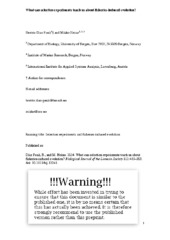What can selection experiments teach us about fisheries-induced evolution?
Peer reviewed, Journal article
Accepted version

Åpne
Permanent lenke
https://hdl.handle.net/1956/16363Utgivelsesdato
2014-03Metadata
Vis full innførselSamlinger
Originalversjon
https://doi.org/10.1111/bij.12241Sammendrag
There is evidence that fisheries are altering the phenotypic composition of fish populations, often in ways that may reduce the value of fish stocks for the exploiters. Despite the increasing number of theoretical and field studies, there is still debate as to whether these changes are genetic, can be reversed, and are occurring rapidly enough to be considered in fisheries management. We review the contribution that selection experiments have already provided with respect to the study of the evolutionary effect of fisheries, identify issues that still require more study, and outline future directions for doing so. Selection experiments have already been crucial in showing that harvesting can lead to phenotypic and genetic evolution over relatively short time frames. Furthermore, the experiments have shown the changes involve many other traits than those under direct selection, and that these changes tend to have population-level consequences, including a decreasing fisheries yield. However, experiments focused on fisheries-induced evolution that fulfil all our requirements are still lacking. Future studies should have more controlled and realistic set-ups and assess genetic changes in maturation and growth (i.e. traits most often reported to change) to be more relevant to exploited populations in the wild.